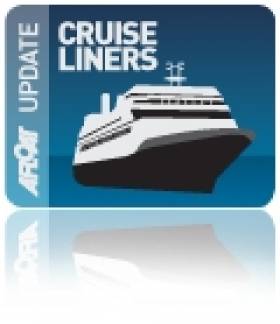Displaying items by tag: New Cruise Terminal
New £20m Cruise Visitor Centre Launched at Greenock, Inverclyde
One of Scotland's main cruise ports, Greenock Ocean Terminal, Inverclyde is where a new £20 million cruise ship visitor centre is looking ship-shape after it was officially launched.
The project, led by Inverclyde Council, is part of the £1 billion Glasgow City Region City Deal funded by the Scottish and UK governments (£10.4m), with contributions from Peel Ports (£8m), operators of the existing Greenock Ocean Terminal, and the George Wyllie Foundation via Dunard Fund (£1.7m).
The aim of the development was to increase visitor numbers to 150,000 passengers a year and that has already been surpassed.
The project is expected to provide a £26m boost to the Scottish economy and over 70 jobs have also been created.
The dedicated cruise ship visitor centre features an arrivals/departure hall operated by Peel Ports Clydeport, as well as a museum and art gallery, the Wyllieum, paying tribute to the late, world-famous artist George Wyllie, who worked as a Customs Officer in Greenock and lived for many years in Gourock.
There is also a high-end Scotts restaurant and roof terrace with panoramic views of the River Clyde that has created over 70 jobs.
A new 200-metre floating pontoon was also completed by Peel Ports in partnership with the council as part of the overall project, providing a dedicated cruise ship berth linking to the state-of-the-art new visitor centre.
Discovering Belfast Harbour’s Cruiseship Potential
#CruiseBelfast – Discovery is to open the Belfast Harbour cruise season in late March with up to 750 passengers calling to the port out of a total of 110,000 visitors expected this year, writes Jehan Ashmore.
In 2013, Belfast Harbour handled around 60 cruiseships, a record for the port that represented a 45% jump in passengers and crew, up from 75,000 to 110,000 in just one year. It was estimated the associated spend generated more than £18m for the local economy and in opening up Northern Ireland in general as a visitor destination.
Once again, many of the leading cruise operator brands are calling to the harbour in 2014, among them; Princess Cruises, Holland America Line, Celebrity, MSC, Thomson, Fred Olsen Cruise Line and Saga Cruises. In addition the port is to welcome several cruise callers for the first time, they are the FTI Berlin, Kristina Katarina, Louis Aura and the sail-assisted Club Med 2.
As previously reported, Belfast Harbour is building the first purpose-built cruise terminal in Ireland, which is to attract a wider global audience of cruise passengers using the £7m facility which is due for completion this year. Cruise ships will then transfer from Stormont Wharf in Co. Antrim, the main existing berth on the north side of the Lagan to the opposite bank adjacent to Alexandra Dock in Co. Down.
The new terminal, to include a 2.5 acre area for coaches and a welcome centre to showcase Northern Ireland, will also be within walking distance of Titanic visitor attractions - Titanic's Dock & Pumphouse, Titanic Belfast, SS Nomadic and the WWI battle-cruiser HMS Caroline which is to undergo restoration work.
The facility will handle all cruise ships currently visiting Irish Sea ports but is also designed to cater for 'next generation ships' capable of accommodating 4,500 passengers and crew.






























































